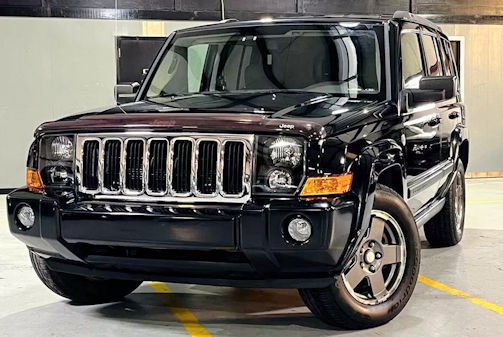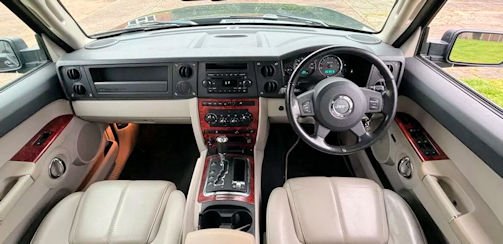Jeep Commander
 |
|
|
Production period: |
2006 to 2010 |
|
Class: |
Off Road |
|
Body versions: |
station wagon SUV |
|
Engines: |
Gasoline : 3.7-5.7 litres (157-246 kW) |
|
Length: |
4787 mm |
|
Width: |
1899 mm |
|
Height: |
1826 mm |
|
Wheelbase: |
2780 mm |
|
Curb weight: |
2078-2450 kg |
The Jeep Commander is a seven-seat all-terrain SUV owned by the Chrysler Group's Jeep brand.
History
Based on the Jeep Grand Cherokee undercarriage, it entered as the top model within the Jeep model range. The version with 3.0-liter V6 diesel engine from Mercedes-Benz was produced exclusively in Graz for the European market.
The angular body shape of the Jeep Commander recalls the old Jeep Cherokee XJ; vertical window surfaces and headlights as well as flared wheel arches are supposed to create a particularly masculine appearance. Unlike the Grand Cherokee, the Commander is exclusively equipped with seven seats.
The Commander was initially available in the trim levels Sport and Limited. The sport included the basic version with fabric seats and no chrome trim, while the better-equipped Limited is equipped with leather seats including heated seats and parking assistance.
Since the model year 2008, only the variants Limited and Overland (the latter available since 2007) are available in Europe as well as a few copies of the Sport variant. The Limited is the upscale version. This includes an exclusive interior trim package with leather trim on the dashboard and a HDD navigation system with Bluetooth hands-free kit and rear-view camera, as well as a glass electric sunroof and two additional roof windows (second row of seats) included in the equipment. The Overland offers compared to the Limited essentially a nobler leather interior (two-tone), a further improved four-wheel drive system (Quadra Drive II) and Xenon headlights.

Terrain Properties
The Jeep Commander is in contrast to many other SUVs also a full off-road vehicle.
The data:
- Slope angle front: 34 °
- Slope angle rear: 27 °
- Ramp angle: 20 °
- Wading depth: 508 mm
- Ground clearance: 210 mm
- Four-wheel drive system Quadra-Trac II (equipment Sport and Limited)
- Four-wheel drive system Quadra-Drive II (equipment Sport and Overland)
All equipment variants include a standard 5- speed automatic transmission and a convertible third row of seats (seven seats). The 5.7-Hemi V8 engine is available since 2008 only in conjunction with the Overland equipment.
The engines in Europe include a 160 kW (218 hp) 3.0-liter V6 diesel engine from Mercedes-Benz and the 5.7-liter Hemi V8 engine. The 4.7-liter V8 with 170 kW (231 hp) is no longer offered since 2008 in Europe. In addition, a smaller 3.7-liter V6 petrol engine with 157 kW (214 hp) and since 2008 a 4.7-liter V8 with 223 kW (303 hp) are available in the USA.
All vehicles manufactured for Europe are exclusively equipped with four-wheel drive and off-road gear reduction. Power is transmitted via an automatic transmission from Mercedes-Benz. The prices are at about the same level as the Grand Cherokee.
Safety equipment
The Jeep Commander comes standard with the following security technologies:
- Anti-lock Braking System (ABS): Electronic sensors prevent the wheels from locking. The ABS improves steering control during full braking or braking manoeuvres on slippery surfaces.
- Electronic Stability Program (ESP): This system helps the driver to maintain directional stability under all conditions under the laws of physics. Especially helpful in critical driving conditions such as in bends and on different road surfaces such as snow, ice or gravel. As soon as there is a clear difference between the steering direction, which the driver prescribes and the direction that the vehicle takes, the ESP deliberately intervenes with brake or throttle position and brings the vehicle back onto the right path.
- Tire pressure monitoring system (TPM / RDC): The system uses pressure sensors in the valves to monitor the tire pressure on all four wheels and constantly sends radio signals to a receiver in the vehicle. If pressure loss occurs, a warning light comes on.
- Electronic Roll Mitigation (ERM): An additional feature of the ESP that uses the data from this system and predicts the risk of a rollover. The system then decreases the engine torque and triggers a short full stop on the corresponding wheel to stabilize the vehicle.
- Brake Assist (BAS): The system detects the initiation of full braking and immediately delivers maximum braking power for the shortest braking distance possible.
- Enhanced Accident Response System (EARS): In the event of an accident, this improved accident response system helps rescue personnel find and reach passengers. After the airbags are triggered, EARS switches on the interior lighting and unlocks the doors. In addition, the system interrupts the fuel supply to the engine.
- Advanced multi-stage triggering front airbags: The system detects and classifies the impact severity and triggers in three stages depending on the impact force.
- Side airbags in the front seats: The airbags are located in the outer sides of the front seats and improve the protection of the driver and front passenger in certain impact situations. Each side airbag has its own sensor, and so only the airbag on the impact side triggers.
- Side curtain airbags: More protection for all passengers on the outside seats. Each side curtain airbag has its own trigger sensor: only the airbag on the impact side is ignited.
- Brake Traction Control: The system detects slippage on individual wheels and selectively brakes slipping wheels and / or reduces engine torque until traction is restored.
- Structural safety cage: Protects passengers with targeted diversion and dissipation of impact energy in the event of an accident.
- Crash Boxes: Body areas that compress in a collision on predefined paths and absorb the impact energy.
- Energy-absorbing steering column: Two coaxial tubes produced by the hydroforming process can shift against each other in the event of an impact so that the steering column does not push into the interior space. The electrically adjustable steering column has a calibrated bending element, which deforms in an accident and optimally dissipates the impact energy.
- Side impact protection: Struts in the front and rear doors offer passengers protection in the event of a side impact.
- Head impact protection in the interior: components that have been specifically developed to minimize the forces acting on the head. These include the columns above the waistline, instrument panel, structure of the roof and side struts and the pulleys of the seat belts.
- Belt tensioners: In the event of a collision, the impact sensors activate the belt tensioners and pull the front seat belts tight. Thus, in a collision, the forward movement of the head and body is minimized.
- Belt force limiter: Doses load-dependent the restraining force of the front seat belts and thus limits the belt forces acting on the body in the event of an impact.
- Height-adjustable straps: Passengers can adjust the shoulder strap to a suitable height; promotes with its comfortable fit the belt application rate.
- Belt Alert: A regular sounding gong reminds the driver to put on the seatbelt until he does.
- Child seat anchor (ISOFIX): Facilitates the installation of compatible child seats.
Technical
-
Engine for Europe
model
capacity
cylinder
engine
power
Max. Torque
Remarks
construction time
gasoline engines
4.7
4701 cc
V8
Chrysler Power Tech
170 kW (231 hp) at 4500 rpm
410 Nm at 3600 rpm
switchable four-wheel drive
05 / 2006-05 / 2008
5.7
5654 cc
V8
Chrysler Hemi
240 kW (326 hp) at 5000 rpm
500 Nm at 4000 rpm
switchable four-wheel drive
05 / 2006-05 / 2009
diesel engine
3.0 CRD
2987 cc
V6
Daimler Benz OM642
160 kW (218 hp) at 4000 rpm
510 Nm at 1600-2400 / min
all wheel drive
05 / 2006-11 / 2010
